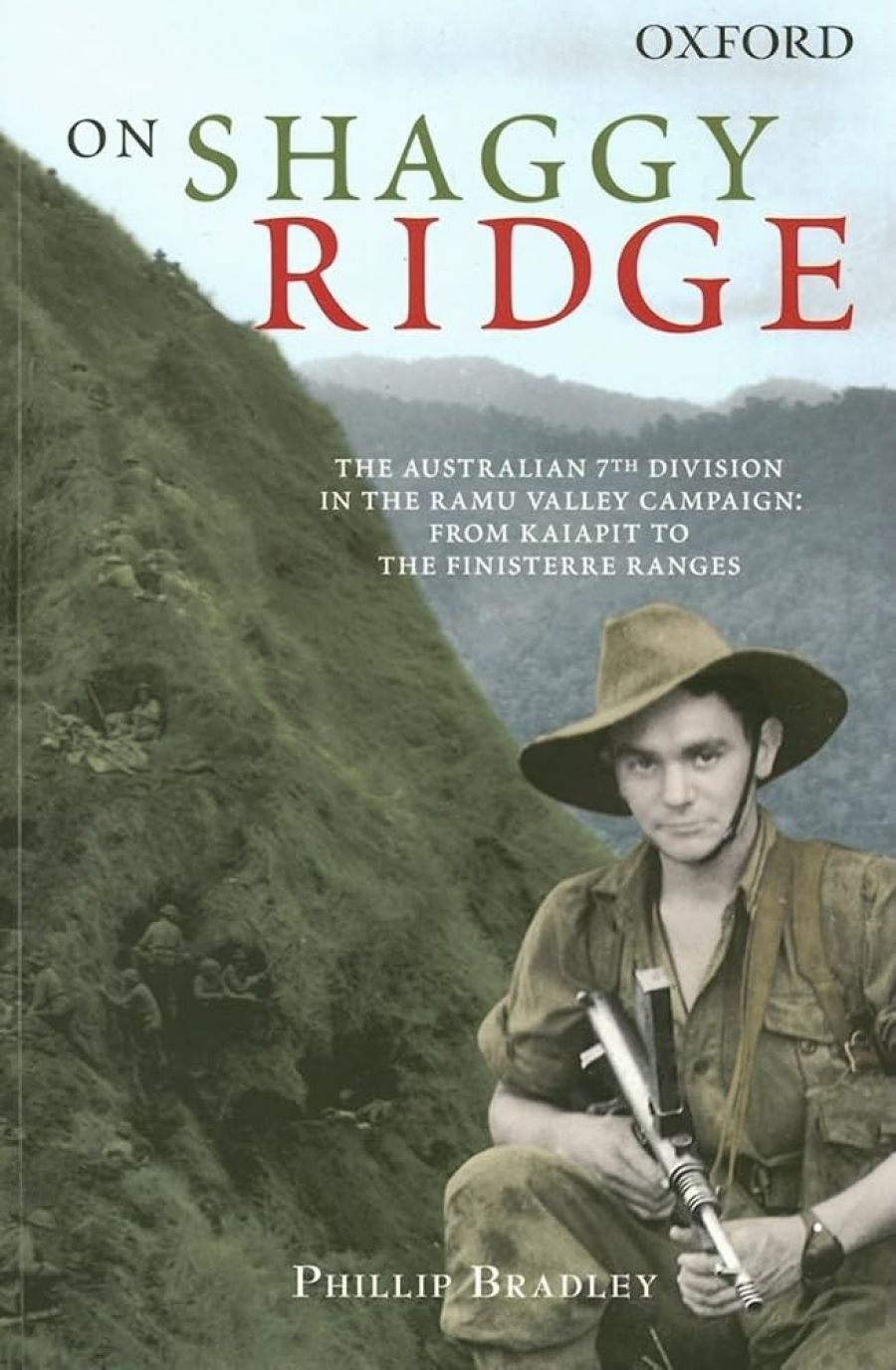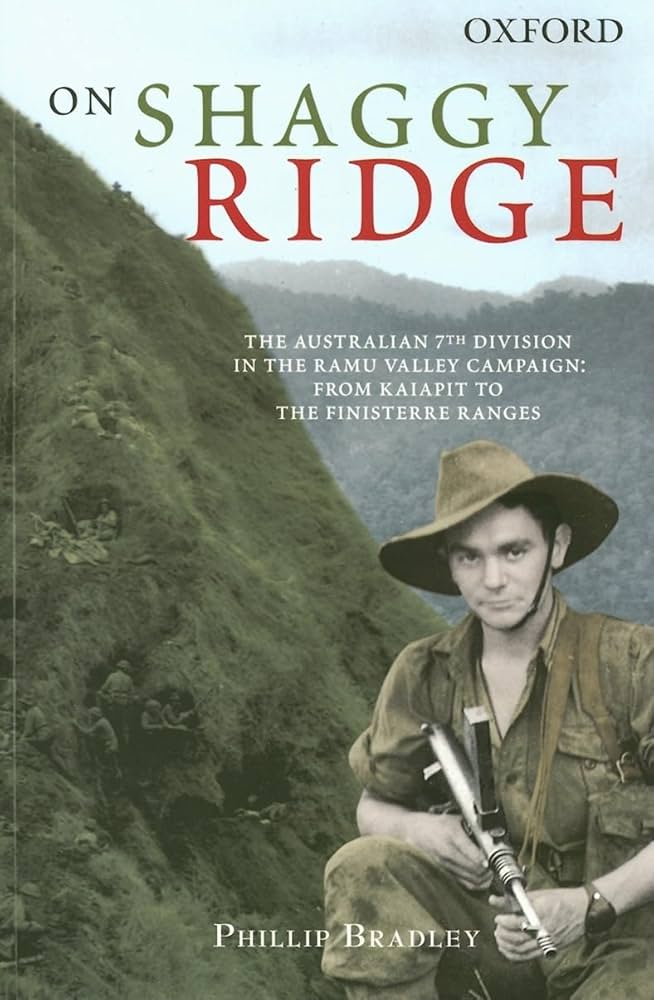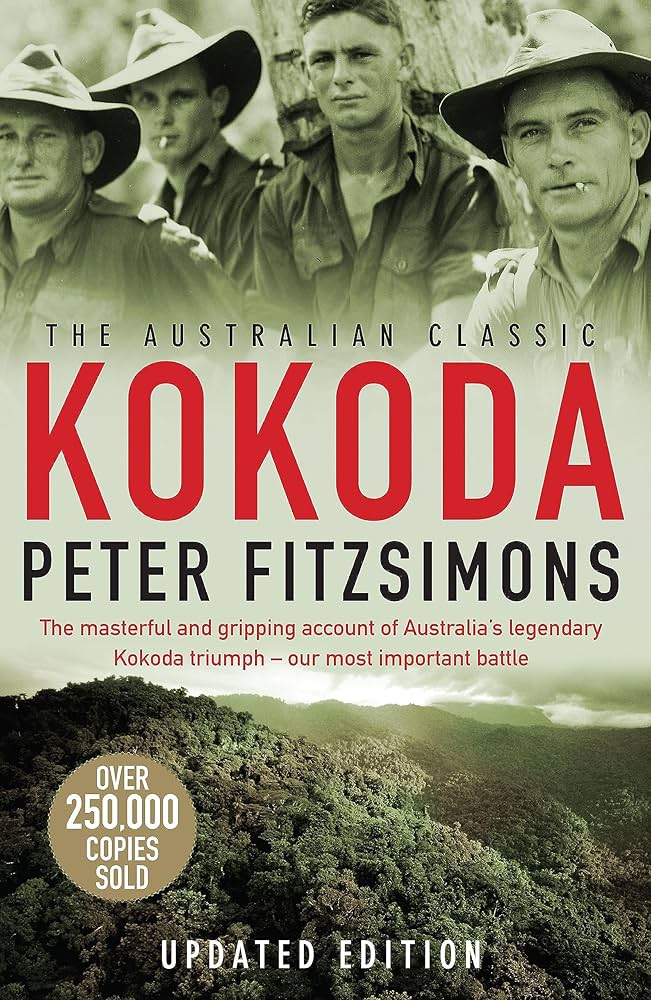
- Free Article: No
- Contents Category: Military History
- Review Article: Yes
- Article Title: Momentous Campaign
- Online Only: No
- Custom Highlight Text:
Of all the campaigns that took place in the western half of Australian New Guinea during World War II, Shaggy Ridge is among the most neglected. It does not deserve this status. There used to be a graphic, brooding diorama depicting the massiveness of the ridge in the Australian War Memorial in Canberra; unfortunately, it has been removed and replaced by other exhibits.
- Book 1 Title: On Shaggy Ridge
- Book 1 Subtitle: The Australian seventh division in the Ramu Valley
- Book 1 Biblio: Oxford University Press, $55 hb, 284 pp
- Book 1 Cover Small (400 x 600):

- Book 1 Cover (800 x 1200):

- Book 2 Title: Kokoda
- Book 2 Biblio: Hodder, $49.95 hb, 490 pp
- Book 2 Cover Small (400 x 600):

- Book 2 Cover (800 x 1200):

In September 1943, when this phase of the Allied campaign to retake the area started, the: Japanese defenders had been in and around the ridge for many weeks. Not only did they know the area thoroughly, they had established strong points in all the key approaches to it; removing them would clearly demand time and great skill.
Phillip Bradley, in On Shaggy Ridge: The Australian Seventh Division in the Ramu Valley, has written an excellent account of the campaign and the tough fighting that ensued. Because the nature of the ground made it virtually impossible for Major-General George Vasey’s troops of the 7th Australian Division to take out the ridge in one hit, much of the book is given over to the myriad small actions that had to be undertaken to wrest the surrounding features from the Japanese before concentrating on the ridge. Hence, the first weeks were spent in patrol actions and small unit probes to establish how strong the Japanese were, and what approaches gave the best opportunities to command the ridge itself. After a courageous attempt by troops of the 2/16th Battalion, supported by accurate artillery fire, to force the ridge along its one-man front, the ridge and the nearby key features of Kankiryo Saddle and the Crater eventually fell to a multi-pronged assault by Brigadier Fred Chilton ‘s 18th Brigade, supported by other troops and accurate air support.
The battle descriptions are given added zest by the great number of participants whom the author has interviewed – 140 in all – and by the use of Keith Mitchell’s excellent maps, which give much-needed perspective to a campaign where the contours are close and the broken nature of the country in the Finisterre Mountains (literally ‘end of the earth’) make tactical descriptions difficult to follow.
On Shaggy Ridge is not for the faint-hearted. While it is of considerable value to the specialist historian, its densely scripted detail makes it tough going for the general reader. Bradley has worked so assiduously to interview as many surviving veterans as he can find that he strives to give them all a place in the narrative. Thus, in one paragraph, the reader is told that in addition to Corporal Ted ‘HiHo’ Silver, an outstanding section leader and original member of 9 Platoon, others there on that day with 9 Platoon were: ‘Corporal Bill Palfrey ... Johnny Twine, Billy Howarth, Ernie Clifford, “Lofty” Back, Johnny Cobble, Gordon “Happy” Davies, Bill Patterson, Bobby Malcolm, Alf Edwards, Claude Lamport, Ralph Cudby, Percy “Puddin” West, Bill “Toby” Thomas, Hugh “Lofty” Norton, Len Edwards, Mick Oates, Bill “Yogi” Kerr, Noel Sanderson, George Allen, Peter Lockett, “Dick” Martin and Sergeant Jack Arnold on attachment.’ Terrific stuff in a battalion newsletter, but here such a detailed listing could be better handled in a footnote or endnote.
The second of these books, Peter FitzSimons’s Kokoda, is different altogether. FitzSimons is better known as a biographer of politicians such as Kim Beazley, and rugby greats such as John Eales. In the preface to Kokoda, he states that on the strength of the success of his biography of Nancy Wake, he was approached by that book’s publisher to write the story of the Kokoda Track. His answer to that request was ‘a succinct No’. Eventually, and obviously, he changed his mind. The result is a book of almost five hundred pages that seems at first sight to have been written on a popular theme just to capture a market. The reader’s apprehension is compounded when FitzSimons admits that even though an uncle of his fought on the Kokoda Track, ‘I only had a foggy idea what the fighting along the Kokoda Track had been all about. Sure, I knew our blokes had gone up against the Japanese – and I gathered that they had done pretty well – but that was close to all I knew.’ Later, he admits that he is not an historian, but that, in fleshing out a great number of facts that his researchers had assembled for him, his aim has been to connect those pieces into a story that reads ‘at least a little like a novel’.
Well, a war novel about the fighting in New Guinea in the style of T.A.G. Hungerford’s incomparable The Ridge and the River (1952) this book is not, yet it succeeds remarkably well for all that.
Although the story of the fighting along the Kokoda Track – in contrast to Shaggy Ridge – has been recounted many times by authors of the quality of Peter Brune, David Horner, Lida Mayo Samuel Milner and Dudley McCarthy, to name a few, FitzSimons has an ease of style and an ear for dialogue that make his narrative a pleasure to read. For that reason, his book is likely to reach a far wider audience than might be the case with more specialised texts. In fact, because FitzSimons has relied heavily on an obviously competent research assistant, and has come to the subject without prejudices of his own, there is a considerable value in the fresh look that he gives it. He has a good eye for the spectacular examples that support generalised themes, and the storyteller’s knack of crafting it into a narrative that moves along at a brisk pace. His lack of military background occasionally plays him false. I doubt that many infantry soldier would agree that the main purpose of the companies within a battalion is to protect battalion headquarters; they have many other offensive and defensive tasks. And especially in the ‘no-front’ circumstances of jungle warfare, those at headquarters quickly learn to shift for themselves.
The book does not introduce any new material but what it does very well is to enrich our knowledge of many men who, although not necessarily fighting troops themselves, did much to ensure the survival, success and recognition of others. The pre-war knowledge and experience of Bert Kienzle and Tom Grahamslaw were vital in understanding and mobilising the native porters, without whom the Australian campaign would have ground to a halt. In the process, they ensured that recognition of the porters was elevated from the pejorative ‘boong trains’ to ‘Fuzzy Wuzzy Angels’. The contributions of the journalists-cum-historians Chester Wilmot and Osmar White, and of Damien Parer – Australia‘s greatest war photographer of that conflict, who was later killed while filming the American Marine landing at Peleliu Island – were incalculable in giving a human face to the fighting along the Track.
A compelling contrast, which the author pursues relentlessly, is that between the courage and resourcefulness of the front-line troops and their commanders, such as Lieutenant Colonel Honner of the 39th Battalion, Brigadier Arnold Potts and Lieutenant-General Syd Rowell, with the shoddy treatment they received from men such as Generals MacArthur and Blamey, who did not visit the front-line or anywhere near it, but nagged from the rear. That their own reputations also hung in the balance in the event of failure does nothing to excuse their lack of empathy and foresight.
Whether this book continues its life as a film script (which may have been one of FitzSimons’s aims) or via radio or the Internet, it is an eloquent account of a momentous period in Australia ‘s military experience.


Comments powered by CComment